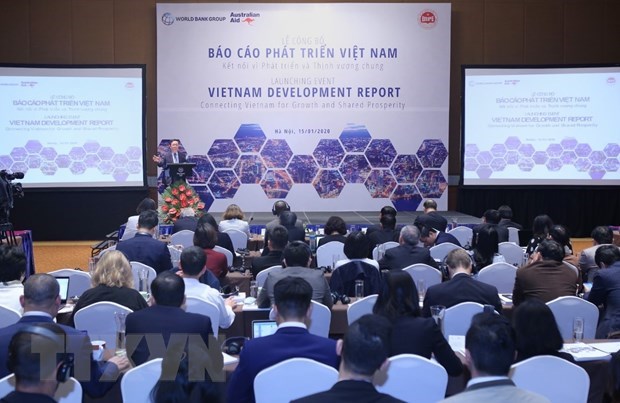Trade competitiveness limited due to lack of domestic connectivity
 Ousmane Dione – Country Director of the World Bank in Vietnam addresses the event. (Photo: VNA)
Ousmane Dione – Country Director of the World Bank in Vietnam addresses the event. (Photo: VNA)
Hanoi (VNA) - Vietnam is among the most open economies in the world with a trade-to-GDP ratio of 187.52 percent in 2018. Merchandise export growth averaged more than 15 percent per annum in the last ten years, nearly five times the global export growth.
Accordingly, the country's export basket has improved in its technological content and has diversified in both markets and products. However, there are many challenges facing Vietnam's export performance.
These are comments made in the "Vietnam: Connecting value chains for trade competitiveness" report published by the World Bank on January 15.
Actively offset from domestic market
Pham Minh Duc, senior economist of the World Bank, said that the country’s remarkable achievements in trade liberalisation were strengthened through the removal of both tariff and non-tariff barriers and fulfilling Vietnam’s commitments in several regional trade agreements, including the ASEAN Free Trade Area Agreement (AFTA), the US-Vietnam Bilateral Trade Agreement (US-BTA), the participation in the World Trade Organisation (WTO) and the Comprehensive and Progressive Agreement for Trans-Pacific Partnership (CPTPP).
[PM signs directive to promote digital enterprises]
Thanks to the remarkable achievements from trade activities, Vietnam's per-capital GDP increased nearly fourfold from less than 500 USD in 1992 to over 1,800 USD in 2017, while the poverty rate dropped from around 53 percent in 1992 to 2 percent in 2016.
However, the research team also reported that there are many challenges facing Vietnam's export performance. Many export products have low value addition, and Vietnamese enterprises only perform primarily assembly functions. In addition, trade costs remain high compared to the average regional level.
On the other hand, domestic enterprises’ participation in global value chains is limited, while export performance is largely driven by the foreign direct investment (FDI) sector, accounting for more than 70 percent of total exports. In this context, Vietnam will likely be able to maintain its high export performance even if these challenges are not addressed.
According to Ousmane Dione, Country Director of the World Bank in Vietnam, it is necessary to have a further vision and the enhancement of the connection of the domestic market will promote the country’s continuous development while ensuring that when any latent decline in exports comes in, it can be offset by higher domestic demand.
 Report "Vietnam: Connecting value chains to enhance trade competitiveness," published by the World Bank. (Photo: VNA)
Report "Vietnam: Connecting value chains to enhance trade competitiveness," published by the World Bank. (Photo: VNA)
Lack of policy orientations to promote connectivity
According to the report, Vietnam’s trade competitiveness is limited due to a lack of policy orientations to promote the connection of trade orientations.
One of the most visible issues is the uneven development of transport infrastructure plus congestions at major border gates, leading to a serious imbalance between supply and demand.
According to Duc, Vietnam's trade flows are concentrated at one quarter its international border gates - two airports, five seaports and five border crossing points - which collectively handle 86 percent of total trade value.
In addition, the domestic transport system depends largely on roads, making up about three-quarters of the volume of goods. Meanwhile, Vietnam has a wide network of rivers, but it has not taken advantage of the network, because the system of harbours and ports is yet to be suitable and meet the general requirements for transporting large volumes of goods.
More specifically, the goals of trade growth and competitiveness improvement have not been clearly linked to the goals of making policies on connectivity and investment in transport infrastructure. Information on trade, especially value chains, is rarely used in making and implementing connectivity policies. Meanwhile, policy making and investment for transport infrastructure development lack in-depth analysis on spatial structure and connectivity trends in different segments of the value chain.
Therefore, Duc said, Vietnam needs to have policies to connect and invest in transport infrastructure with more focus on trade through integrating analysis results based on assessment of connection on the comprehensive value chain as well as analysis on the situation of trade gateways into these policies.
“We recommend that connectivity policies and master plans on transport as well as investment priority in transport infrastructure should be developed and carried out in the direction of promoting trade in a clearer and stronger manner. To do the matter, an effective interdisciplinary coordination mechanism must be established, including facilitation for trade and logistics, thereby enhancing trade competitiveness,” he said./.













